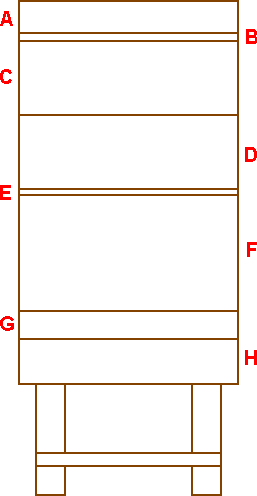
I have spent thousands of hours researching and designing beekeeping equipment (for UK use).
I hope some of what I have learned in the process will be useful to others.
"A" Is the roof (aka lid, telescoping cover or outer cover).
"B" This is the crownboard (aka coverboard or inner cover).
"C" Is a super for honey storage, but sometimes this position is occupied by a section rack. On other occasions this position might be occupied by an overall feeder.
"D" Is a super. (There may be any number of these and they are commonly shallower than the boxes used for brood.)
"E" Is a queen excluder.
"F" This is the brood box or brood chamber (but may consist of more than one box).
"G" The floor (aka bottom board) goes here but is sometimes replaced by a pollen trap.
"H" A stand is not absolutely essential in all conditions, but wherever damp weather prevails it is advisable.
